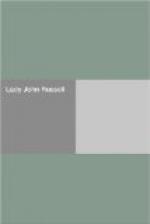East of the house was a long lawn, secluded from the open Park by a beautiful, wildly growing hedge of gorse, berberis, bramble, hawthorn, and wild roses. Further north was a bowling-green, surrounded by hollies, laburnums, lilacs, rhododendrons, and forest trees; at one end was a rose-trellis and a raised flower garden. The effect of this bright flower garden with its setting of green foliage and flowering shrubs, and majestic old trees surrounding the whole, was very beautiful. At one end, shaded by two cryptomereas, planted by our father—said by Sir Joseph Hooker to be among the finest in England—was a long verandah where our mother often sat in summer with her basket of books, and in winter spread oatmeal for the birds, which grew very tame and would eat out of her hand. Close by was a picturesque old thatched summer-house, covered with roses; on each side were glades of chestnut, hornbeam, and lime trees, and looking westward Windsor Castle could be seen on the far horizon.
Near the house was a noble cedar, with one particularly fine bough under the shade of which the Petersham School children and the “Old Scholars” had their tea on festive occasions, followed by merry games in the grounds. The view from the house and the West walk, and also from King Henry’s Mount, was most beautiful, especially in the spring and autumn, with the varied and harmonious tints of the wooded foreground fading away into the soft blue distance.
It was a glorious Park to live in. The great oaks, the hawthorns, the tall dense bracken, the wide expanses of grass, the herds of red and fallow deer, not always undisturbed, made it a paradise for young people. The boys delighted in the large ponds, full of old carp and tench, with dace and roach, perch, gudgeons, eels, tadpoles, sticklebacks, and curious creatures of the weedy bottom. There was the best of riding over the smooth grass in the open sunny expanses or among the quiet and shady glades. Combe Wood, a little south of the Park, was then an island of pure country, quite unfrequented, and an occasional day there was a treat for all.




